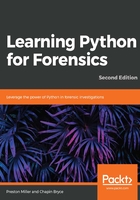
Summary
In this chapter, you learned how to parse a plain text file using Python. This process can be implemented for other log files, including those from firewalls, web servers, or other applications and services. Following these steps, we can identify repetitive data structures that lend themselves to scripts, process their data, and output results to the user. With our iterative build process, we implemented a test-then-code approach where we built a working prototype and then continually enhanced it into a viable and reliable forensic tool.
In addition to the text format we explored here, some files have a more concrete structure and are stored in a serialized format. Other files, such as HTML, XML, and JSON, file structure data in a manner that can be readily converted into a series of Python objects. The code for this project can be downloaded from GitHub or Packt, as described in the Preface.
In the next chapter, we will explore the methods in Python that we can use to parse, manipulate, and interact with these structured formats.